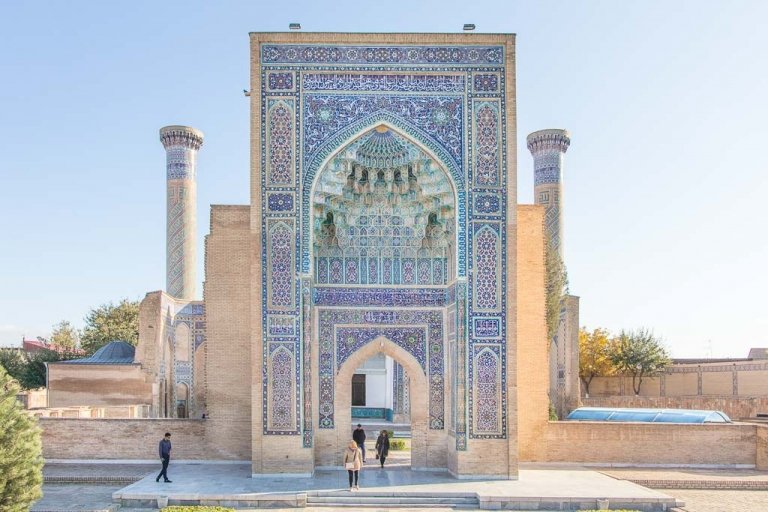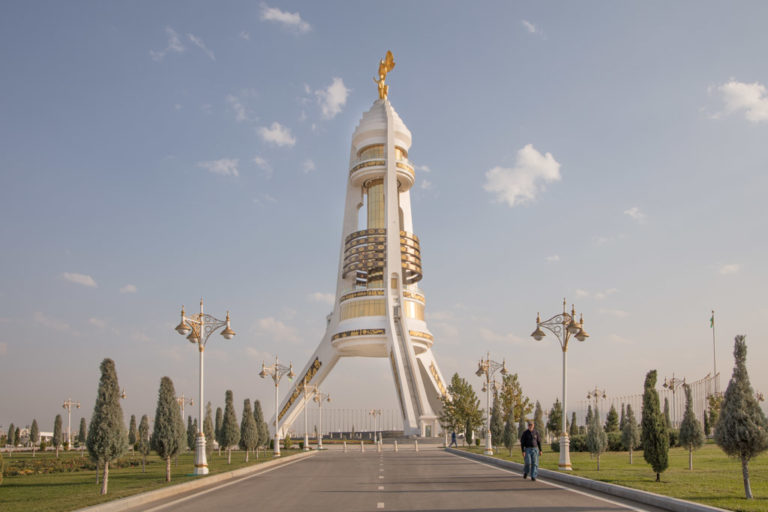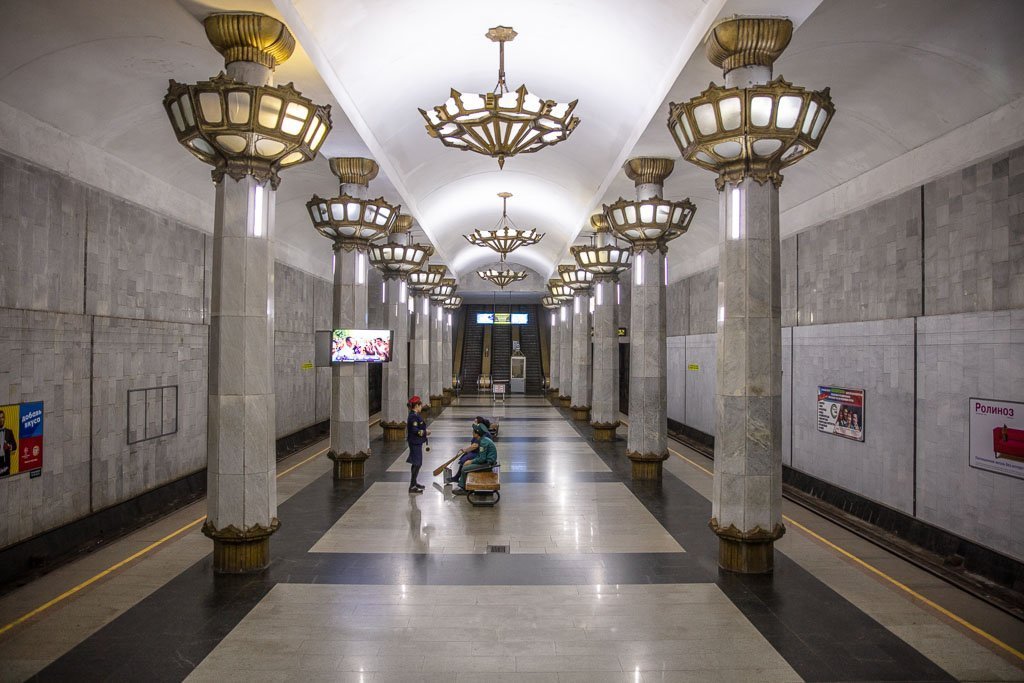
A Guide To The Tashkent Metro Stations
Updated May 2023, A Guide To The Tashkent Metro Stations was originally written in October 2019
I spent a big chunk of my 30th birthday underground a few years back. I had never thought of public transport as something that could be so grand until I found myself cruising the Tashkent Metro stations.
In October 2019 I finally had the chance to return to Tashkent, but a major change had occurred in the Tashkent Metro between then and now: it was now perfectly legal to take photos of the ornate Tashkent Metro stations.
Tashkent Metro is renown across the globe as one of the most beautiful subway systems the world over. But for all these years it remained almost a secret, revealing her stunning interior to only the eyes of those that commute the Tashkent Metro daily and of travelers that made the journey to Uzbekistan’s capital city.
I had a mission on my recent return: photograph every single of the 29 Tashkent Metro Stations.
Update: As of May 2021, there are now 31 stations on the three existing lines. Turkestan Station and Yunusobod Station were added to the Yunusobod Line. A new line called Yer O’sti opened as well, bringing seven additional stations.
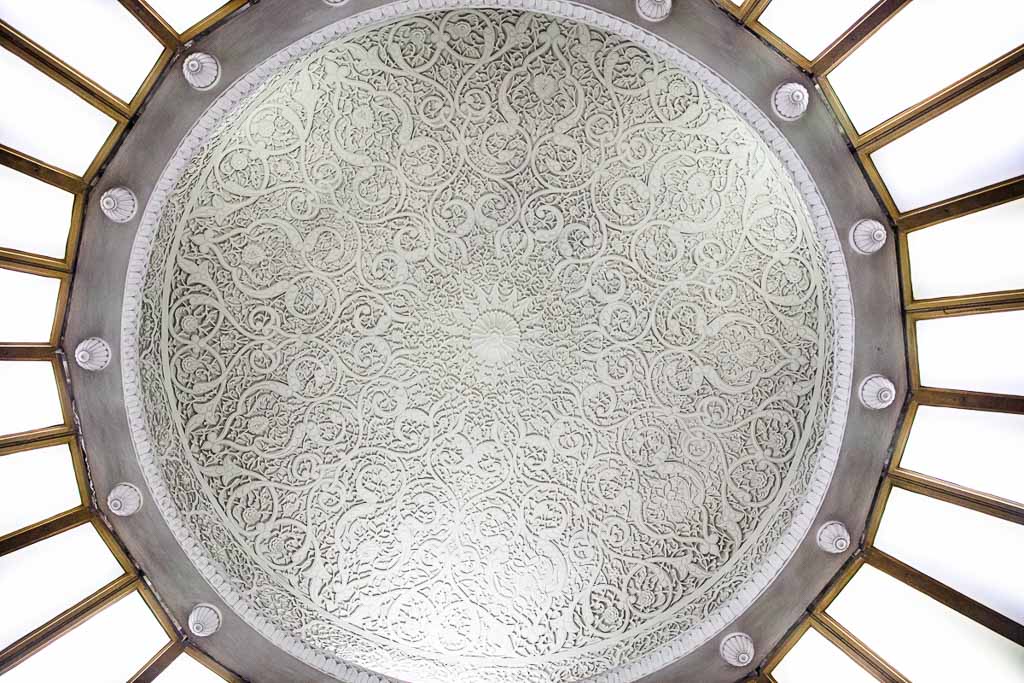

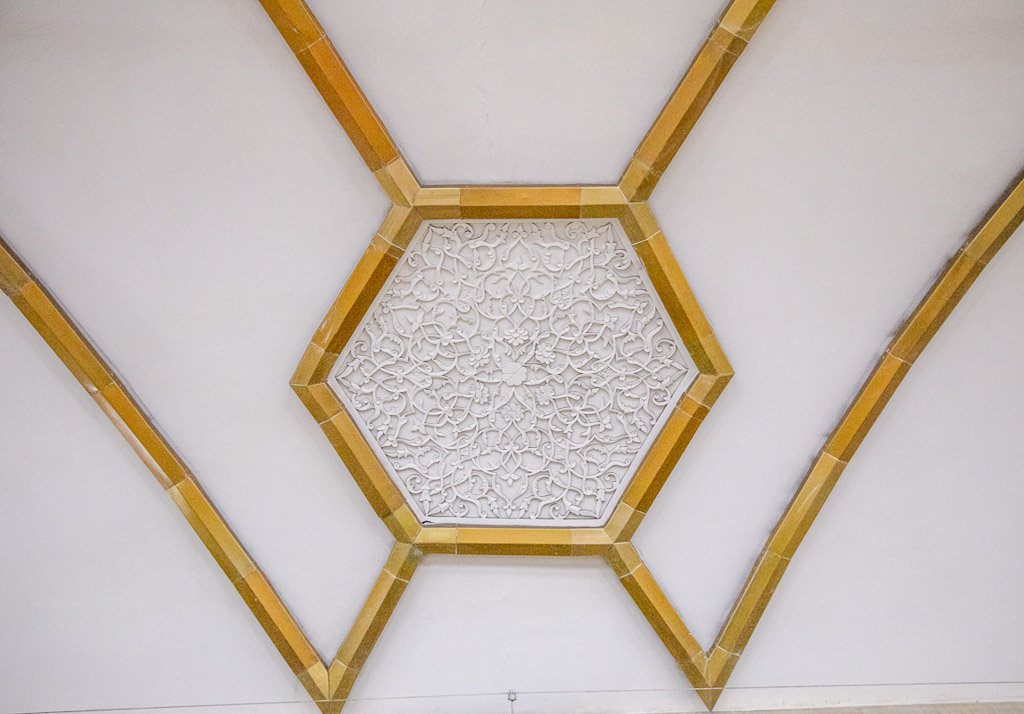
Great success.
In two days I visited and photographed all 29 metro stations as I re-explored Tashkent once again. Earlier in the trip, I began my journey in Almaty, Kazakhstan as part of an assignment with USAID.
In the early morning hours, a few of us set out to zip along the rails photographing Almaty’s Metro Stations. Almaty’s metro is gorgeous, however, Tashkent has it beat.
Getting to go back to Tashkent and visiting each of the metro stations was a highlight of my return. Since I had no pictures of any of them for my first trip to look at it almost felt like my first time all over again.
In this guide to the Tashkent Metro, you’ll find everything you need to know, from ticket costs, operating hours, history on the architecture and artwork of each station, personal favorites, and more.
Start Here: The Complete Uzbekistan Travel Guide
and get your copy of Bradt Uzbekistan to help you plan your trip
- Olmazor Station (Formerly Sobir Raximov)
- Chilonzor Station
- Mirzo Ulugbek Station
- Novza Station (Formerly Hamza)
- Milliy Bog Station (Formerly Yoshlik)
- Xalqlar Do’stligi Station (Formerly Bunyodkor Station)
- Pakhtakor Station
- Mustaqillik Maydoni Station
- Amir Timur Hiyobuni Station
- Khamid Olimjan Station
- Pushkin Station
- Buyuk Ipek Yoli Station
- Dostlik Station (Formerly Chkalov)
- Mashinasozlar Station
- Toshkent Station
- Oybek Station
- Kosmonavtlar Station
- O’zbekiston Station
- Alisher Navoi Station
- Gafur Gulom Station
- Chorsu Station
- Tinchlik Station
- Beruniy Station
- Ming Orik Station
- Yunus Rajabiy Station
- Abdulla Qodiri Station
- Minor Station
- Bodomzor Station
- Shahriston Station (Formerly Khabib Abdullaev)
- Yunusobod Station
- Turkestan Station


Quick History Of The Tashkent Metro
Traveling through Tashkent’s Metro stations is like taking a journey through Uzbekistan’s history from antiquity to present. Partially built during the Soviet era, the Tashkent Metro was the first underground to come to Central Asia, in fact, it would be the only one to be operational before the collapse of the USSR.
Under the Soviet Union, only cities with populations larger than 1 million would get a metro line. Of course, Moscow was the first, followed by St. Petersburg, Kyiv, Tbilisi, Baku, Kharkiv, and finally Tashkent. In the 1960s Tashkent was experiencing a population surge that pushed up and over the 1 million mark.
Construction of the Tashkent Metro began in 1972, a few years following the devastating 1966 earthquake that left over 300,000 homeless. The government decided to build Tashkent into the model Soviet city, which included this metro system.
In 1977 the first line, Chilonzor was opened with nine stations serving Tashkent. O’zbekiston, the second line of the metro was opened in 1984. By 2001, long after the collapse of the Soviet Union the third line, Yunusobod was opened, though the line still is not fully complete.
Work is ongoing on the third line, and plans laid for a fourth line (Sirg’ali) and fifth line (Halqa) to come in the future.
Until June 2018 photography was illegal as the Tashkent Metro was still considered a military installation owing to the system’s secondary role as a nuclear bomb shelter, though the only line technically deep enough to be effective in the event of nuclear warfare was Yunusobod, built long after the end of the Cold War.
The metro stations still to this day blend Soviet and Uzbek history, however, since the fall of the USSR in 1989 many Soviet relics have been removed. Each station portrays a snippet of Uzbek history, telling the story with influences from the Arabs, Mongols, Silk Road period, and Soviet-era through grand architecture, mosaics, sculptures, and reliefs.
Read: A Two Week Uzbekistan Itinerary
Important Info
Cost


A Tashkent Metro token will set you back a whole 1400 Uzbek Som ($0.15 USD) per ride. You can buy your tokens at the ‘kassa’ window at the entrance to each platform.
Update 2021: Tokens are no longer issued. You will be given a printed receipt that you scan to enter the metro station.
Theoretically, you could visit all of the metro stations on only one token if you don’t leave any of the platforms, which would be a long stint underground factoring that it took me roughly 4.5 hours to visit and photograph each and every station.
Hours Of Operation

The Tashkent Metro is open every day from 5 am to midnight, giving you plenty of time to take a self-guided tour of the Tashkent stations in a single day.
Peak hours on the metro are from 7:30 am to 9 am and again from 5 pm to 7 pm, coinciding with rush hour traffic. Personally, I found a couple of sweet spots from 9:30 am-11:15 am and 2 pm-4 pm on weekdays that were relatively quiet and great for shooting photos of the stations without too big of crowds. I also found after 8 pm to be great for photography as there were so few people around.
Metro trains depart stations about every 5 minutes, though during the peak hours are reduced to 2-3 minutes. After 9 pm the frequency increases to every 10 minutes, running on a slower schedule.
Plan your visit: The Tashkent Travel Guide
Tashkent Metro Map

Security
Upon entering the Tashkent Metro you’ll need to pass through a security check just beyond the kassa window. You’ll pass through a scan and your bags may be checked. On each platform, you’ll see security guards dressed in green uniforms policing the stations in addition to the countless cameras inside each station.

Tashkent Metro Stations
Chilonzor Line (Red)
Chilonzor was Tashkent’s first metro line, opening in 1977. The line consists of 12 stations. Personal favorites include Mustaqillik Maydoni, Novza, Buyuk Ipek Yoli, and Khamid Olimjan.
Olmazor Station (Formerly Sobir Raximov)

Olmazor Station opened in 1977 under the name Sobir Raximov, after the Soviet-Uzbek WWII hero, but in 2010 the station was renamed. The station connected Tashkent’s most populated southern district with Tashkent’s city center.
Olmazor Station is rather simple in design with a traditional star motif on the floor and stone pillars featuring carvings that depict scenes from the Great Patriotic War. Olmazor is at the southern terminus of the Chilonzor Line.


Chilonzor Station

With golden crowns embellished in crystal lights hanging from a white arched ceiling, Chilonzor Station feels elaborate and grandiose. Chilonzor was one of Tashkent’s first metro stations that opened in 1977 connecting the Chilonzor District to the center of Tashkent. Colorful ceramic murals on the walls feature typical scenes from farmers at work to men having glasses of chai atop a tapchan.


Heading to Central Asia for the first time? Read my Beginner’s Guide to Central Asia Travel
Mirzo Ulugbek Station

Mirzo Ulugbek was the grandson of Amir Timur and a famous 15th century astronomer. The station opened in 1977 but wasn’t named after the Timurid Sultan until 1992 when the name was changed from 50 Let SSSR (50 Years of the USSR). Mirzo Ulugbek Station has a simple and Soviet vibe to it with square geometric patterns on the floor and reddish-brown stone pillars that are wider at the top than at the base.
Novza Station (Formerly Hamza)

In 2015 the station was renamed Novza from the old name of Hamza without any notice, angering Monday morning commuters who missed their stop upon not hearing the name Hamza read over the train speakers (the same day Khabib Abullaev Station was renamed Shahriston).
Hamza Niyazi was a famous Uzbek poet and helped the Soviets lead the (Hujum) anti-veil campaign. Inside the station, the white arched ceiling is adorned with clusters of gold-rimmed lights in the shape of hexagons emulating the appearance of honeycombs. Each cluster has one hexagon that is of white stone with traditional carvings.
Novza Station opened in 1977.

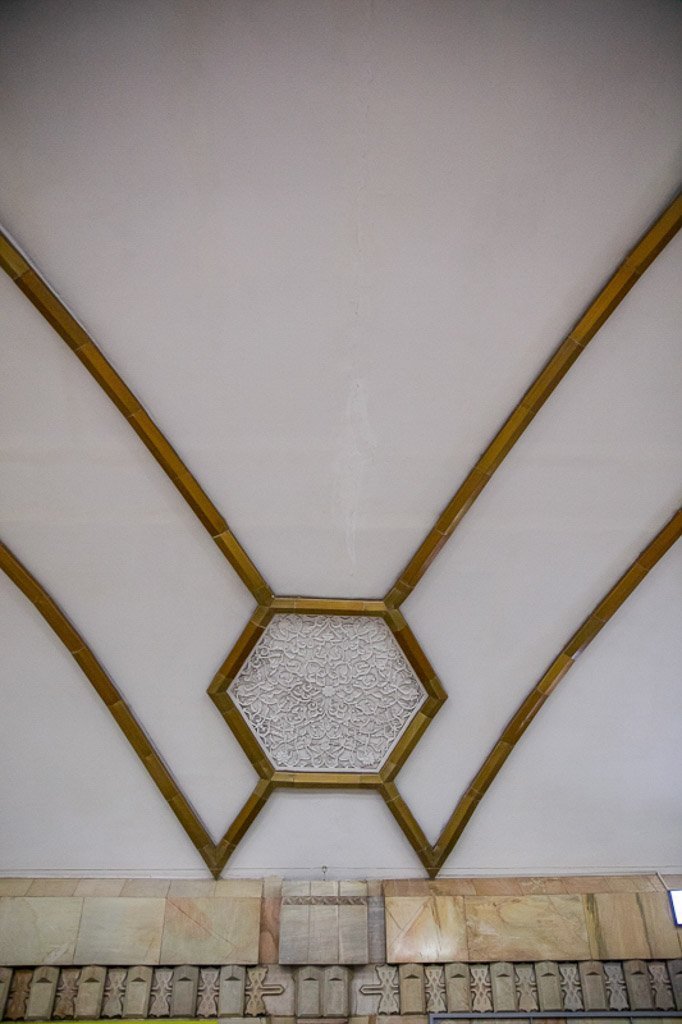
Milliy Bog Station (Formerly Yoshlik)

Milliy Bog translates out to ‘national garden’, which is a fitting name for a station giving access to the large Navoi Park, chock full of eccentric Soviet-era monuments and buildings. With marble pillars, black lines on the floor, and detailed white carvings inlaid into two beams on either side of the platform coming down from the ceiling I thought Milliy Bog has a very Soviet-era feel to it.
Milliy Bog Station was named Yoshlik (youth) until 2006 when the name was changed. The station opened in 1977.
Nearby: National Park of Alisher Navoi, Istikol Palace & Oliy Majlis (Parliament).
Going to Bukhara next? Start planning with my Bukhara Travel Guide

Xalqlar Do’stligi Station (Formerly Bunyodkor Station)

The original name of the station, Xalqlar Do’stligi, means ‘friendship of the people’, but in 2008 the station was renamed after the famous Uzbek football club Bunyodkor. In 2018 the station name was officially changed back to Xalqlar Do’stligi once again. The station opened in 1977.
Nearby: Druzhba Square.

Pakhtakor Station
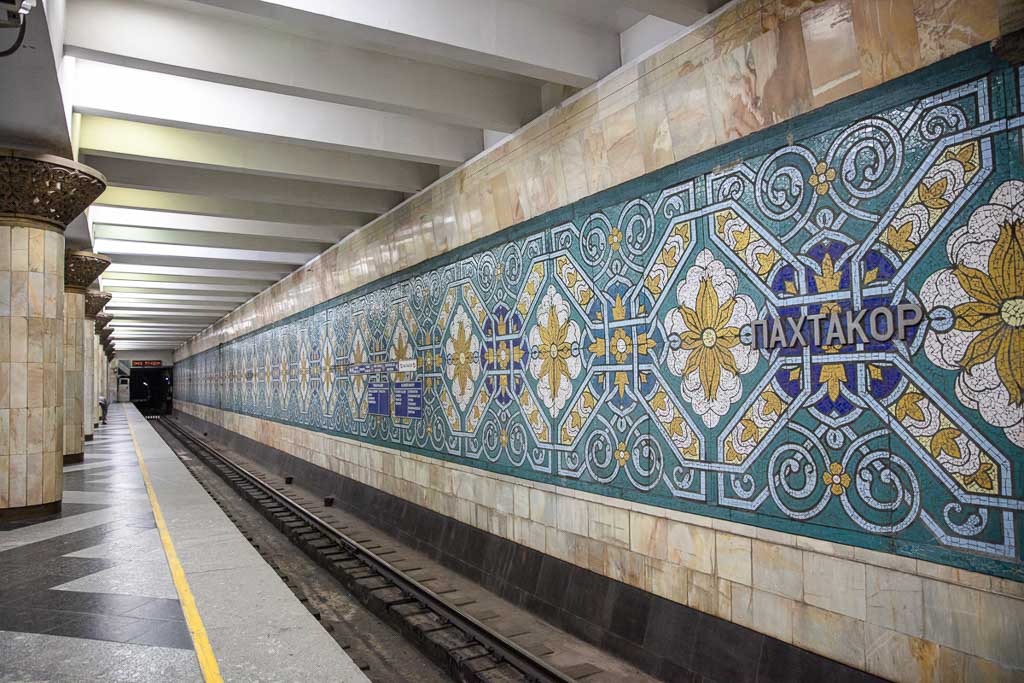
Pakhtakor means ‘cotton picker’ in Uzbek, and the colorful blue-and-yellow mosaics on the walls pay tribute to Uzbekistan’s cotton industry with depictions of blooming cotton plants.
Cotton is an important part of Uzbekistan’s history, but a dark part of it at that. The cotton fields are partially responsible for the drying of the Aral Sea and desertification of the Karakalpakstan region and forced labor of mountain-dwelling people that were made to work in the fields.
Pakhtakor Station opened in 1977 and is an interchange with the O’zbekiston Line.
Learn More About The Little Visited & Fascinating Region Of Karakalpakstan

Pakhtakor Station is an interchange, connected to Alisher Navoi Station on the O’zbekiston Line by underground tunnel.
Mustaqillik Maydoni Station

Mustaqillik Maydoni Station opened in 1977, but it wasn’t until the fall of the USSR in 1991 that the station changed names from Lenin Maydoni to its current moniker- which coincides with the square above ground from it, whose name translates to ‘Independence Square’ in Uzbek.
Mustaqillik Maydoni Station is made almost entirely of marble quarried from the Kyzyl Kum Desert with glimmering walls, bright white columns, and a stunning geometric-patterned ceiling with crystal chandeliers dangling down. The star-patterned floor supposedly represents Mirzo Ulugbek’s contribution to Uzbek history in the way of being an astronomer as well as the grandson of Amir Timur.
Nearby: Independence Square, State History Museum, Art Gallery of Uzbekistan, Crying Mother Monument, Earthquake Memorial, Romanov Palace & Senate Building.



Amir Timur Hiyobuni Station

Formerly named after USSR’s October Revolution, the station was renamed to honor none other than the 14th century conqueror and founder of the Timirid Empire: Amir Timur.
The highlight of the station is the traditional patterns carved into the ceiling. The walls inside the station, as well as pillar details, are made of red marble quarried in Gazgan, a village near Nurata in the Navoi region.
Amir Timur Hiyobuni was opened in 1977 and originally had wall sculptures of the hammer and sickle created by V. Lunev and L. Ryabtsev, but were taken down shortly after independence.
Nearby: Amir Timur Square, Hotel Uzbekistan, Amir Timur Museum, History Museum of the People of Uzbekistan, Navoi Theatre & the Railway Museum.
Heading to the former Timirid Capital of Samarkand too? Check out my Samarkand City Guide

Amir Timur Hiyobuni is an interchange station, linked by an underground tunnel to Yunus Rajabiy Station on the Yunusobod Line.

Khamid Olimjan Station
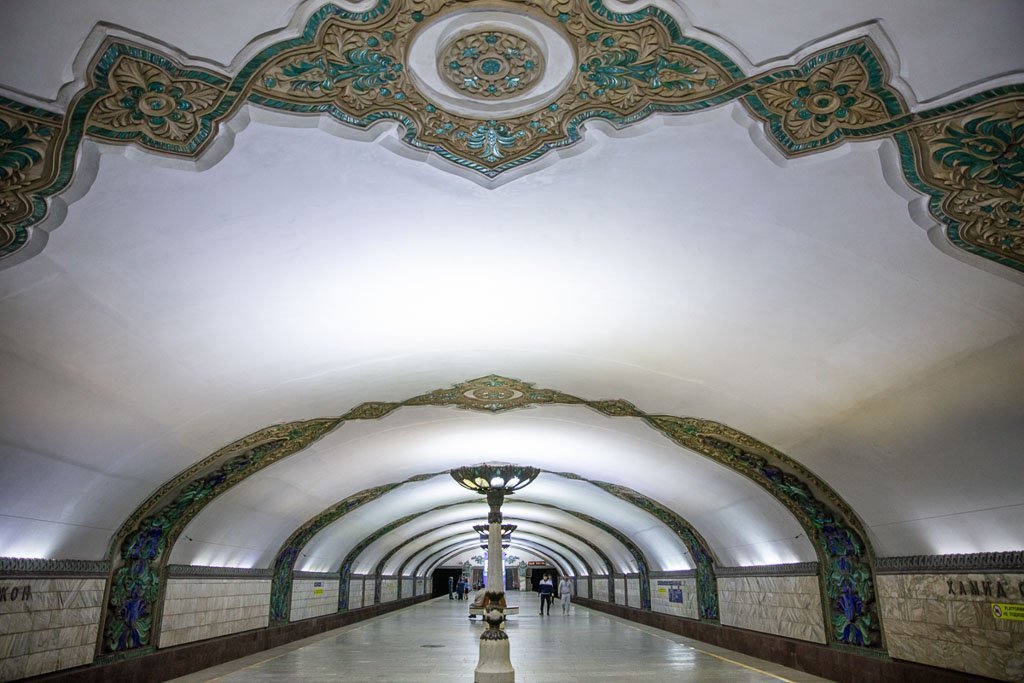
Khamid Olimjan Station opened in 1980 on the Chilonzor Line. Named after the Soviet-era Uzbek poet of the same name, who was widely regarded as one of Uzbekistan’s finest 20th-century poets. He died at the young age of 34 in a car accident in Tashkent.
Khamid Olimjan Station is one of the more unique of the Tashkent Metro with bright white high ceilings and imposing bands of green, blue, and gold ceramic work, illuminated by ornate lamps.

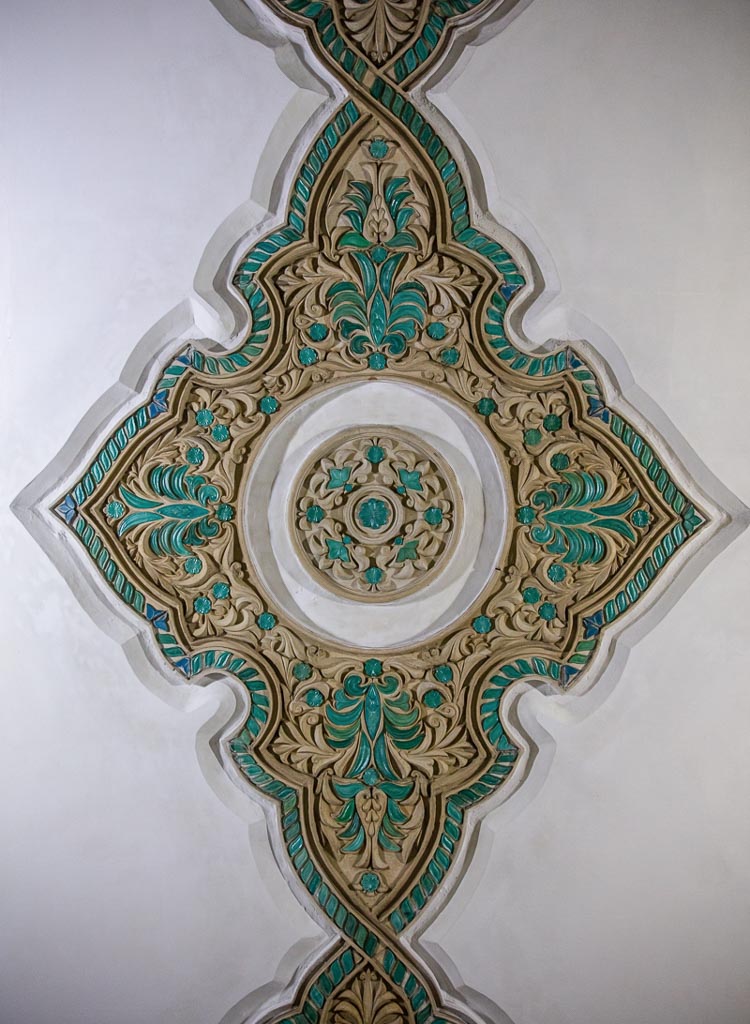
Pushkin Station

Named after the infamous early 19th-century Russian poet Alexander Pushkin, who never visited Central Asia at all but still remains an influence in post-Soviet literature. Hexagonal forms surrounded by square outlines on the ceiling are illuminated by sconces that bear semblance to candelabras clung to marble pillars are the main details immediately noticeable on the platform. Pushkin Station was opened in 1980.
Buyuk Ipek Yoli Station

The Great Silk Road is what the name Buyuk Ipek Yoli translates out from Uzbek to English- which feels sitting given Uzbekistan’s prominent history along the ancient Silk Road. The station is wide and open with rings of lights surrounding carvings on the ceiling.
Buyuk Ipek Yoli Station was originally named after socialist-realism writer Maxim Gorky at its opening in 1980 but changed names to celebrate Tashkent’s position along an ancient and modern Silk Road in 1997. Buyuk Ipek Yoli is the eastern terminus of the Chilonzor Line.
O’zbekiston Line (Blue)
The O’zbekiston line was the second line of the Tashkent Metro to open in 1984. The line has 11 stations. Overall this was probably my favorite line of the metro. My favorite stations were Tinchlik, Kosmonavtlar, Alisher Navoi, Beruniy, and Do’stlik.
Dostlik Station (Formerly Chkalov)

Do’stlik translates out to ‘friendship’, but the station was originally named Chkalov at opening in 1987 after the Soviet hero and Russian test pilot Valery Chkalov. The design of the Dostlik Station was meant to give metro users the feeling of being on an airplane with the ceiling and walls painted a pale blue to mimic the sky with bands of geometric patterned aluminum to mimic the window panels in a fighter jet.
In 2012 the station at the eastern terminus of the O’zbekiston Line was renamed.

Mashinasozlar Station
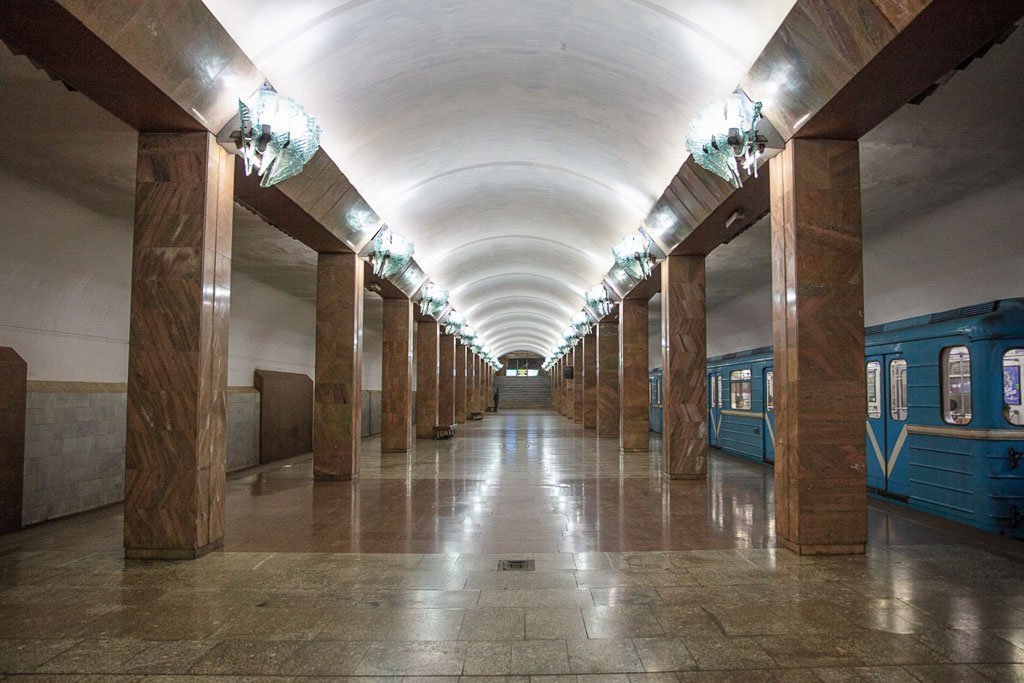
Mashinasozlar Station was opened in 1987 under the name Tashselmash and was renamed Mashinasozlar in 1992. I couldn’t find much information about the name Mashinasozlar which translates to ‘the machines’ but did come across the former name Tashselmash as being the name of a plant that builds the machines that harvest cotton.
Mashinasozlar’s ceilings are plain white and arched with reddish-brown stone pillars each adorned with bluish-white sconces that look to me to be in the shape of a cotton tuft.
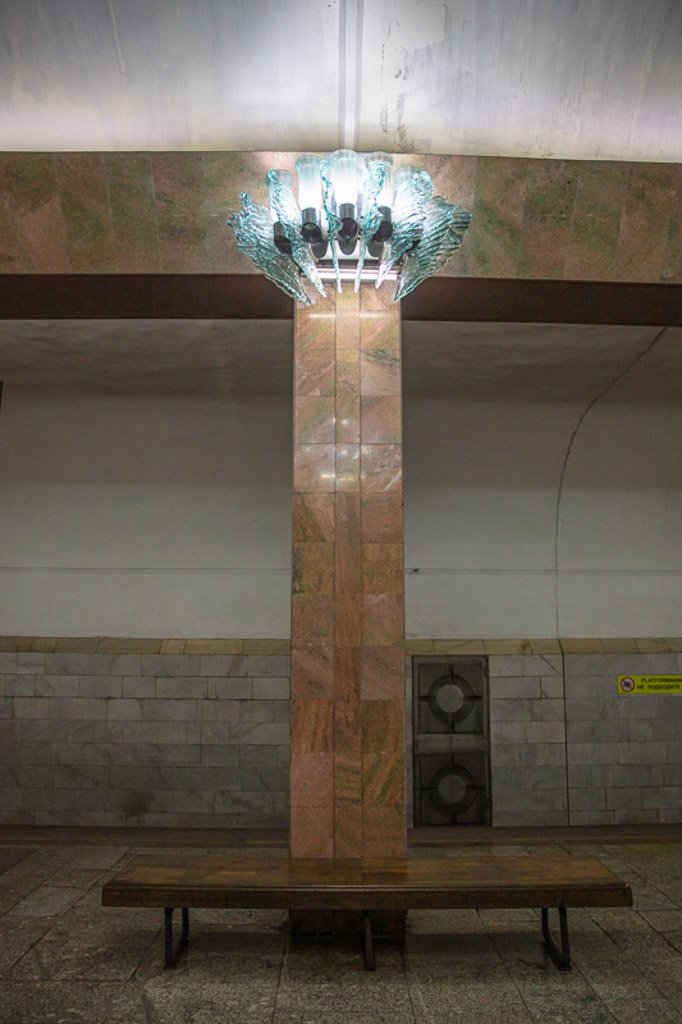
Toshkent Station
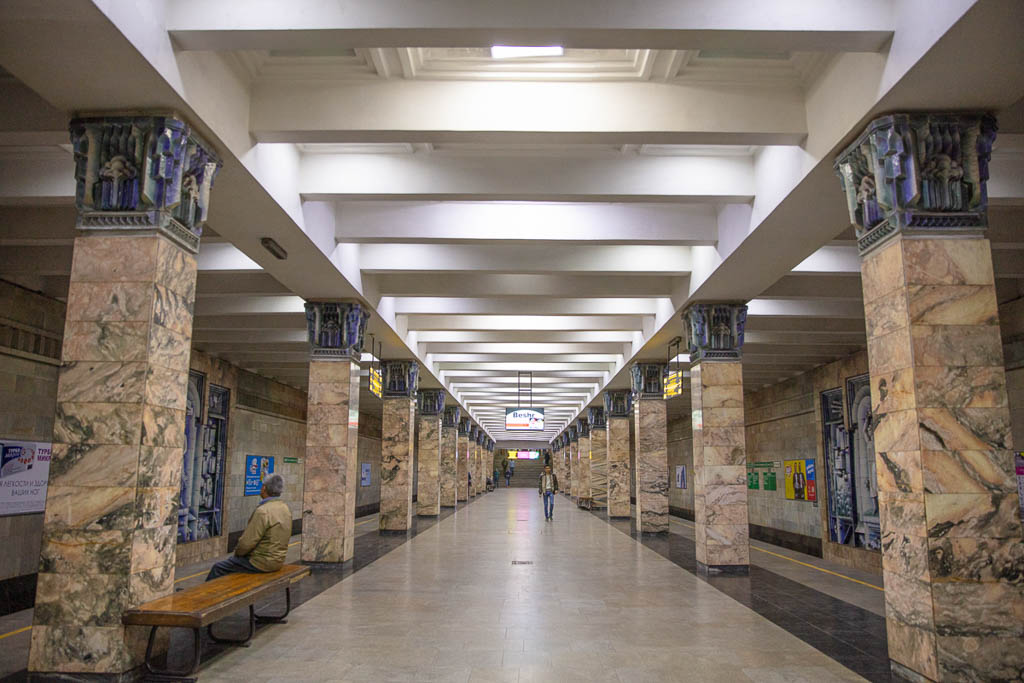
With over 2,200 years of history, Tashkent needed a station dedicated to it right? The walls are adorned with blue-green ceramic murals depicting ‘national spirit’ as well as events in Tashkent’s two millennia-long history.
Toshkent Station was opened in 1984 and was added to serve as a connection to the city’s train station.
Nearby: Tashkent Train Station, Mirobad Bazaar & Cathedral of Assumption (Orthodox Church).



Oybek Station

Oybek Station opened in 1984 and is named in honor of the famous Uzbek poet. The decor of Oybek Station is quite simple with a white arched ceiling and traditional geometric patterns inlaid into the platform columns.
Nearby: State Fine Arts Museum.

Oybek Station is an interchange station connected by an underground tunnel to Ming Orik on the Yunusobod Line.


Kosmonavtlar Station
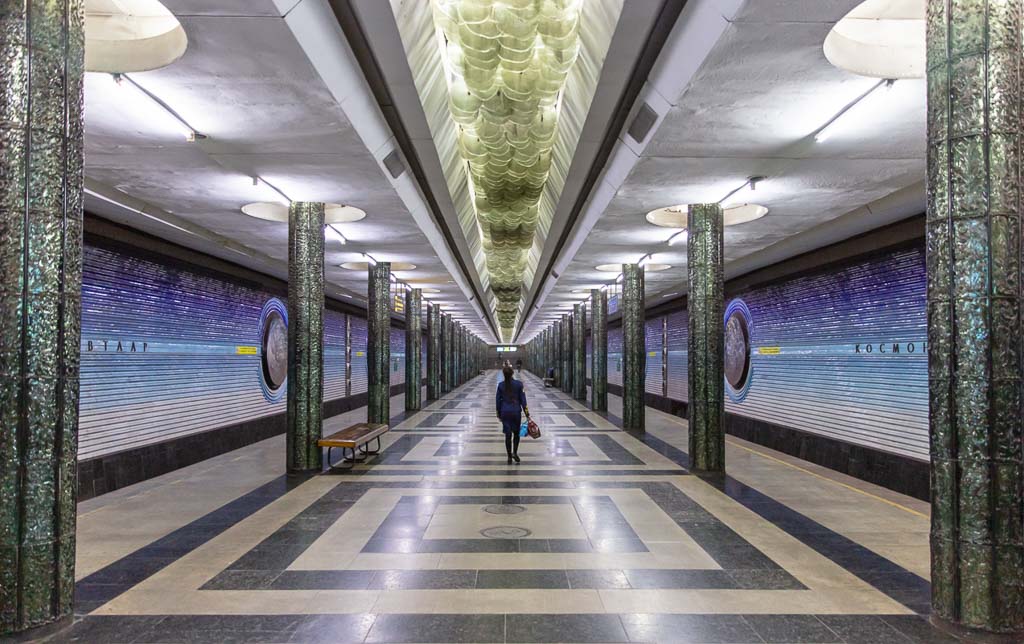
Similar to the Almaty Metro’s Baikonur Station in ‘out of this world’ appeal is Tashkent Metro’s Kosmonavatlar Station. Kosmonavatlar pays tribute to Soviet cosmonaut’s contribution to space exploration.
The walls of the station fade from black to blue to white to represent the appearance of Earth’s atmosphere and the dangling glass on the ceiling lights are meant to give passengers the feeling of gazing up at the Milky Way on a dark, clear night.
Giant circular panels on the walls feature murals of pioneers of the Soviet space program like Yuri Gagarin, Valentina Tereshkova, Vladimir Janibekov, and even important astronomers such as Mirzo Ulugbek. If you’re a space nerd like my friend Val from Valerie & Valise and wanna read up more on famed Soviet cosmonauts you need to check out the best Russian space museums on her second website, Space Tourism Guide.
Kosmonavatlar Station was opened in 1984.
Nearby: Museum of Applied Arts, Republican Puppet Theatre & Ak Saroy Presidential Palace (White Palace).
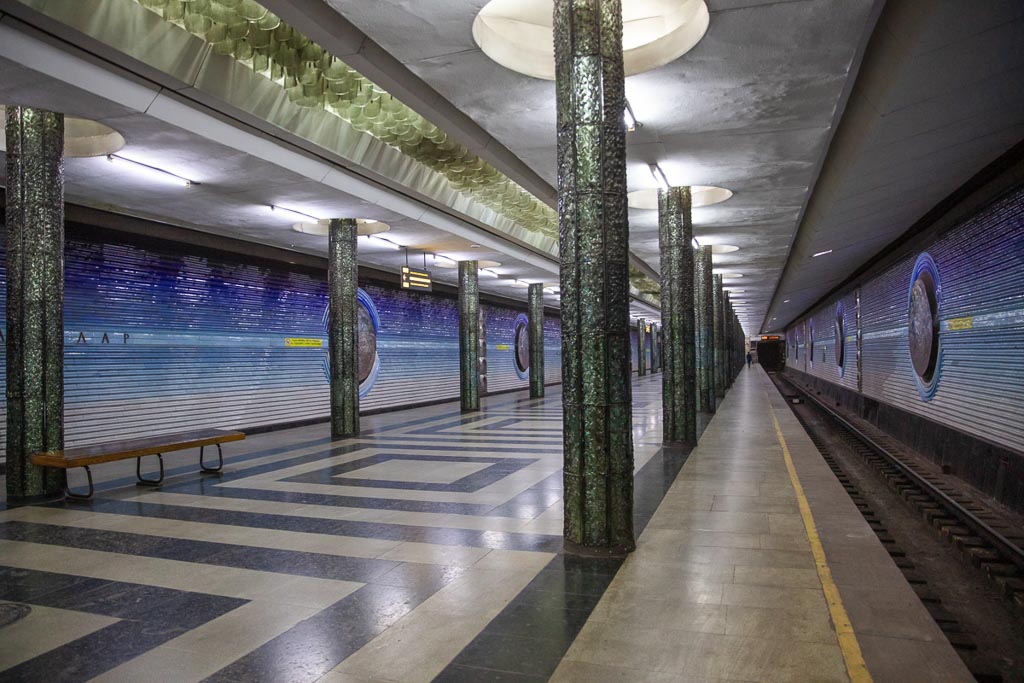

Looking for a cool day trip from Tashkent? Go visit the Solar Furnace in nearby Parkent
O’zbekiston Station

Named after the country itself, O’zbekiston Station opened in 1984 on the line of its same name. Blue glass mosaics form textured wave patterns on the walls giving the appearance of the sea, and bulbous light fixtures pay tribute to the country’s cotton industry, resembling the plant’s white tufts.


Alisher Navoi Station

Opened in 1984 but not completely finished until 1997, this station pays homage to the 15th-century poet, politician, painter, and Sufi mystic Alisher Navoi. Alisher Navoi was born in the city of Herat (in present-day Afghanistan ) under the rule of the Timurid Empire at the time and is regarded by Soviet and Uzbek scholars as a significant influence on the development of the modern Uzbek language (though, not all agree on this).
The ceiling of the station is decorated with pale blue domes with golden details to emulate the mosques and madrasas constructed during the zenith of the Silk Road. The turquoise tile works on the walls depict scenes from Alisher Navoi’s poetry.
Alisher Navoi is an interchange station, connected by an underground tunnel to Pakhtakor Station linking the O’zbekiston and Chilonzor lines.
Nearby: Sheik Khantour Mausoleum Complex, Youth Theater of Uzbekistan & Museum of Communications History of Uzbekistan.




Gafur Gulom Station
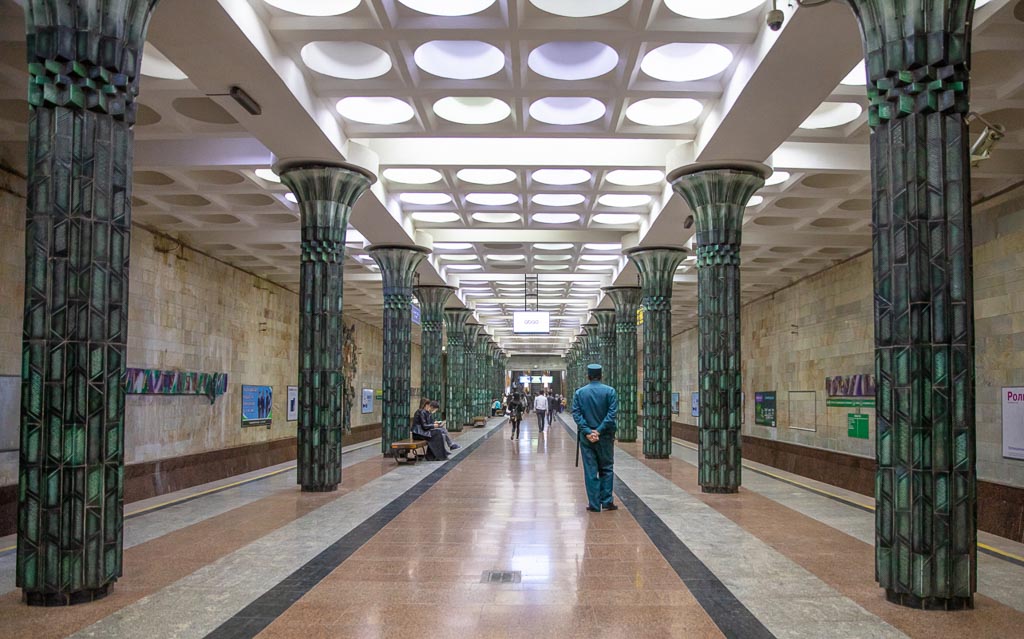
G’afur G’ulom was one of Uzbekistan’s most influential and celebrated poets of his time, most well known for his famous works of Shum Bola and Yodgor. The station is adorned with turquoisey-emerald columns, modernistic mosaics depicting faces and artistic representation of G’ulom’s poetry on the walls of the station, and the ceiling lights hidden inside white domes.
S. Sultonmuradov was the artist brought in to design the station which was operational in 1989.
Nearby: Hazroti Imam Complex, Abu Bakr Kaffal Shoshi Mausoleum, Barak Khan Madrasa & Moyie Mubarek Library Museum.

Chorsu Station

Chorsu Station is aptly named after the blue-domed Chorsu Bazaar that is situated just above ground from the station. The word chorsu translates out to four streams.
The designs on the walls and ceiling of Chorsu Station remind me very much of the lines on the dome covering the main part of the actual Bazaar. Chorsu Station opened in 1989.

Nearby: Chorsu Bazaar, Kulkadesh Madrasa, Joma (Friday) Mosque.

Tinchlik Station

Tinchlik is a small town in the Navoi region of Uzbekistan and subsequently where the marble that the columns of Tinchlik Station are mined. The real draw for me about Tinchlik was the modernist panels on the walls depicting familiar scenes around Uzbekistan, along with the crystal chandeliers hanging from the ceiling.
Mukhamadjon R. and A. Kayumov were the two artists brought in to design Tinchlik Station, the station was opened in 1991.


Beruniy Station

Beruniy is the terminus of the O’zbekiston line. The station opened in April 1991. With a white arched ceiling adorned with geometric patterns and golden chandeliers of crystal, Beruniy is an easy favorite of mine. The station was named after the city of Beruniy in Karakalpakstan.
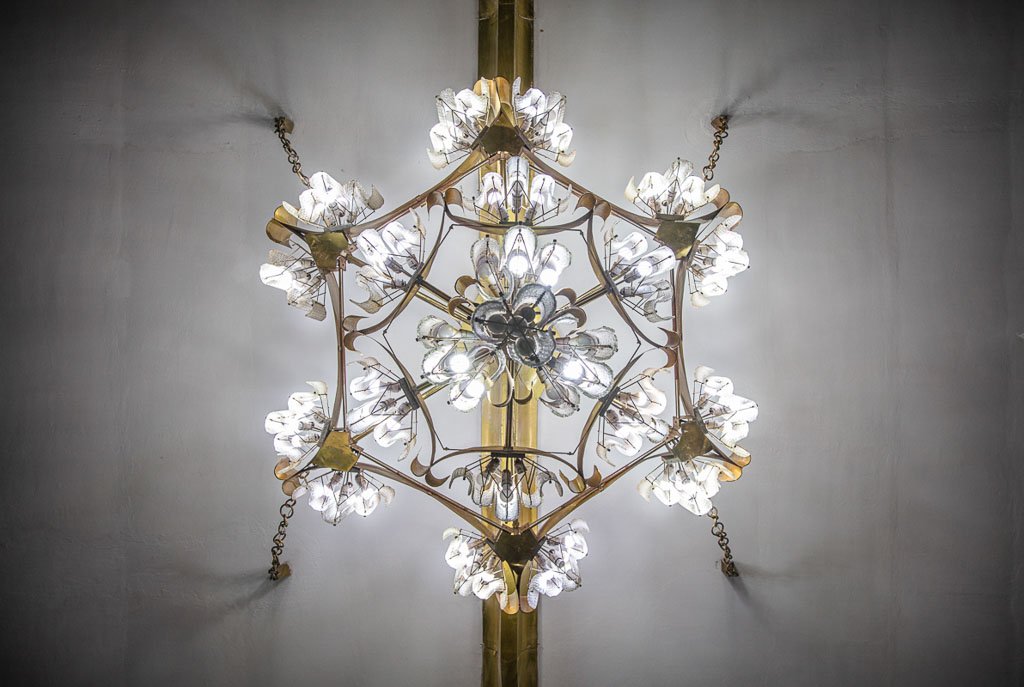

Yunusobod Line (Green)
The shortest and newest metro line on the Tashkent Metro at 6 stations was completed in 2001. Favorite stations include Bodomzor and Yunus Rajabiy.
Ming Orik Station

Ming Orik translates out to ‘thousand apricots’, a testament to the abundance of apricots impossible to miss at the end of summer in Tashkent. What the interior decor has to do with apricots I’m unsure, but the unique chandeliers hanging from squares in the ceiling are worth a look up at.
If you love symmetry Ming Orik Station will feed your fancy (or is it just me that loves symmetry that much?). The station is at the terminus of the Yunusobod Line, but there are future plans to extend it four more stations south.
Nearby: State Fine Arts Museum.
Ming Orik Station is connected to Oybek Station on the O’zbekiston Line by a shiny Underground Tunnel.

Yunus Rajabiy Station

Yunus Rajabiy was a famous 20th-century Uzbek musician and composer. In his honor, the Yunus Rajabiy Station was named after him when it was opened in 2001. The station has high ceilings, beautiful chandeliers, and features tall marble pillars with opulent light fixtures.

Yunus Rajabiy & Amir Timur Hiyaboni form an interchange between the Yunusobod and Chilonzor Lines by way of an underground tunnel.
Abdulla Qodiri Station

Abdulla Qodiri is considered to be one of the most influential Uzbek (and Soviet) writers of the 20th century. He introduced literary realism into his works and inspired a generation of Central Asian creatives. Qodiri was executed during the Stalin Regime’s Great Purge.
Abdullah Qodiri Station was opened in 2001 and named after the famed poet. Don’t forget to look up at the gorgeous chandeliers draped from the ceilings. The blue, red, and green glass mosaics inlaid into the pillars are also worth your attention.
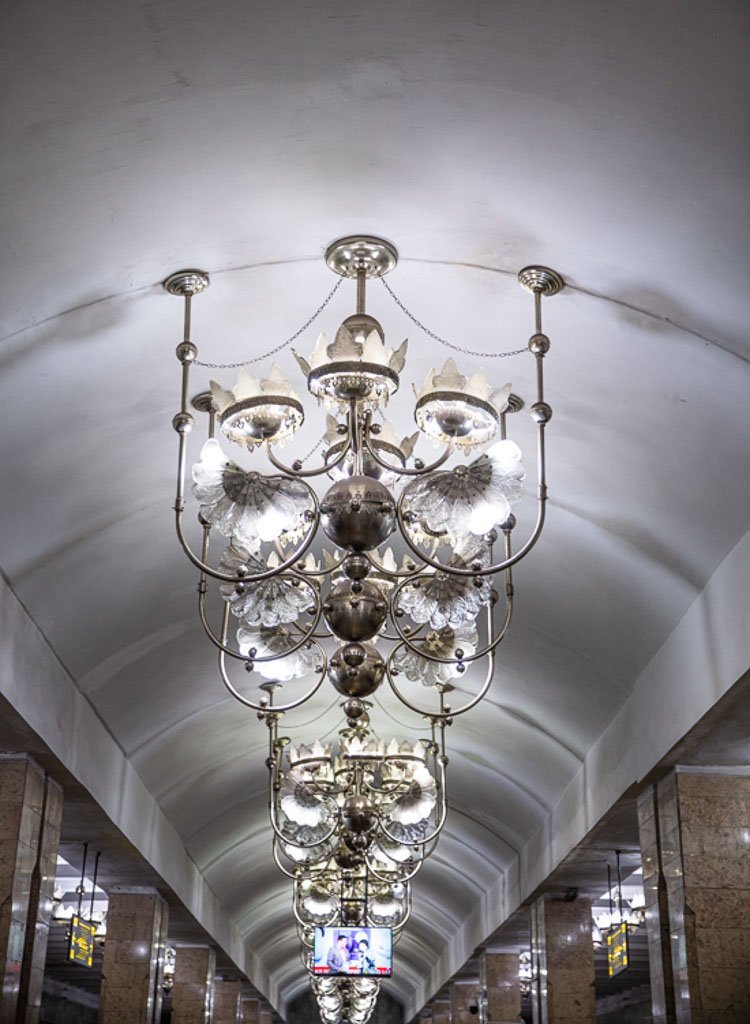

Minor Station

To be honest, Minor was one of my least favorite of the Tashkent Metro stations, and I think it’s because I don’t love the columns that run down the middle of the platform, which in turn does make it unique from other Tashkent Metro stations.
Minor Station was opened in 2001 and bears the same name as the nearby and newly constructed (2016) Minor Mosque, famous for its unique white-stone architecture.
Nearby: Minor Mosque.

Bodomzor Station

Bodomzor Station has a real sci-fi feel to it with the modernistic light fixtures that illuminate the bright white tunnel decorated with pale blue hexagonal-and-star-lines. The circular ceramic reliefs that dot the inside I was told supposedly represent chilis and non– 2 staples of Uzbek cuisine, but personally, I’m unsure of that after re-visiting and looking at the ceramics– you be the judge.
All that said, Bodomzor is one of my favorite Tashkent Metro stations because it’s just so unusual and distinct from the others. Bodomzor Station was opened in 2001.
Nearby: UZexpocenter & International Business Center.




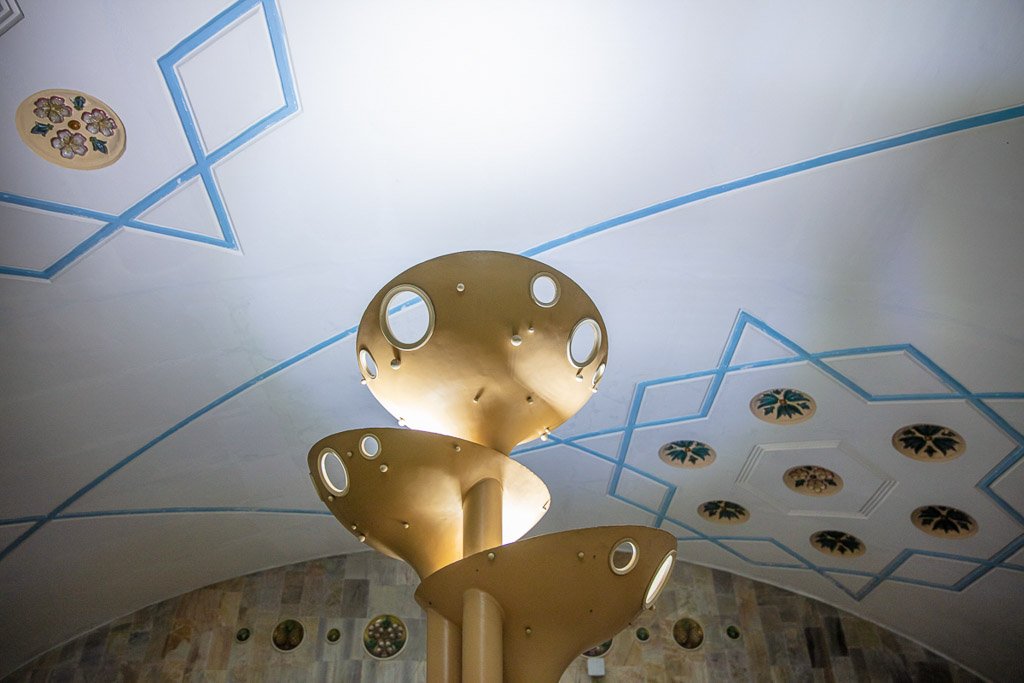
Shahriston Station (Formerly Khabib Abdullaev)

Angering Tashkent Metro commuters in 2015, Khabib Abdullaev Station was renamed to Shahriston Station without any notice as part of Uzbekistan’s ongoing anti-Soviet renaming campaign. Khabib Abdullaev was a geologist with pro-Soviet ideas which lead to the decision to change the name to Shahriston which translates out to ‘the city’.
The station was opened in 2001.
Nearby: Tashkent Tower, Central Asian Plov Center.
Yunusobod Station
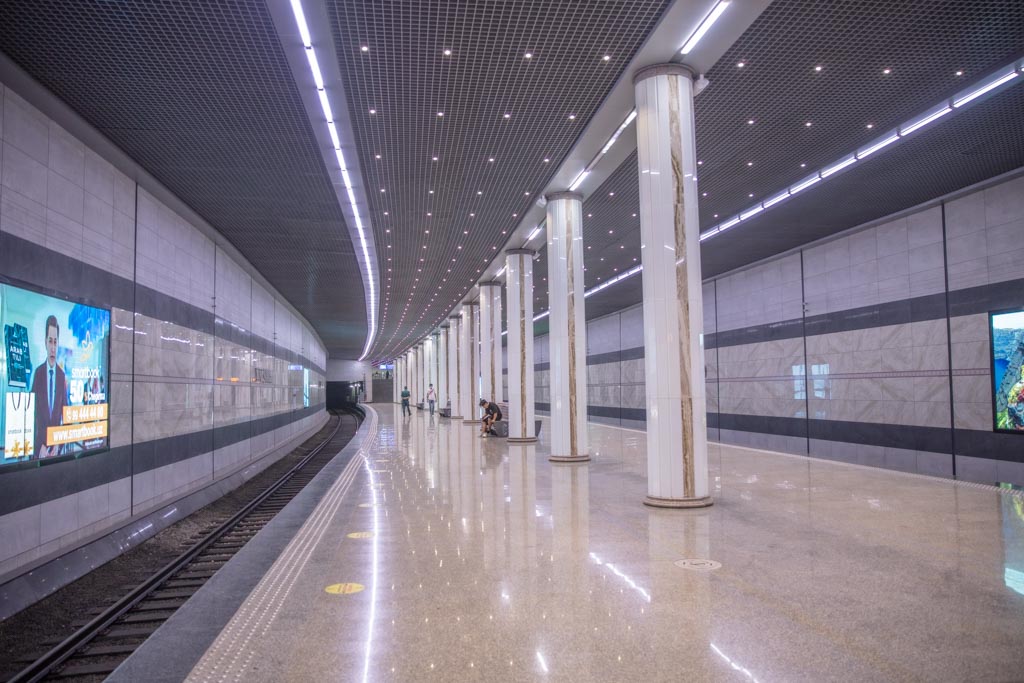
Opened on August 29, 2020, the Yunusobod Metro Station was added to the existing Yunusobod Line. The line was extended to help alleviate road congestion by connecting the Yunusobod area of Tashkent. The station has a futuristic feel to it.
Turkestan Station

Opened the same day with Yunusobod Station, Turkestan Station is now the new terminus of the Yunusobod Line.
The ceiling decor is impressive to say the least with gleaming black designs overlaid on an opulent white backdrop. Reliefs on the wall display famous sites from around Uzbekistan and the greater Turkestan region.

Yer O’sti Line
Beginning August 30, 2020, a new elevated metro opened in Tashkent. The plan is to eventually form a ring around the city, but for right now seven stations are in operation.
The Yer O’sti Line connects with the O’zbekiston Line via tunnel, connecting the stations of Do’stlik 1 (O’zbekiston Line) and Do’stlik 2 (Yer O’sti Line).

The names of the stations are
- Do’stlik 2
- Ohangaron
- Tuzel
- Iltifot
- Rokhat
- Yangiabad
- Kuylyuk
Stations 2-7 more or less look nearly the same, with Do’stlik 2 looking a bit different from the others.



Where To Stay In Tashkent
Budget: Both Art Hostel and Topchan Hostel have come highly recommended by friends of mine. Art Hostel is located about 12 minutes walk from Kosmonavtlar Station and Topchan Hostel is about 30 minutes walk from Toshkent Station.
Midrange: The Rooms Boutique Stay was a great option in Tashkent. The Rooms Boutique Stay is located about 20 minutes walk from Oybek/Ming Orik Stations and near to several restaurants and bars. Another personal favorite is the Art Eco Hotel, located just a 15 minute walk from Pushkin Station.
Have Any Questions About The Tashkent Metro?
Ask your questions about the Tashkent Metro in the comments section below.
Need Travel Insurance for Uzbekistan?
Start shopping plans over at battleface, my go-to travel insurance choice, or over at World Nomads.








